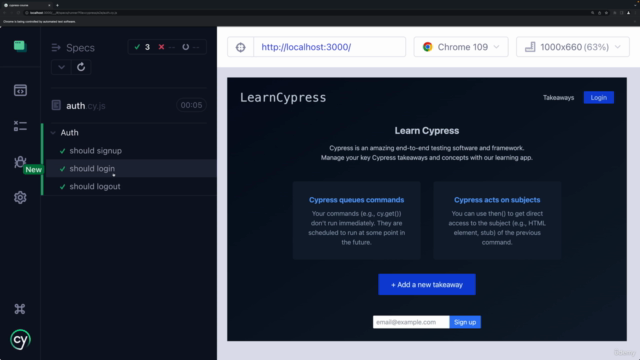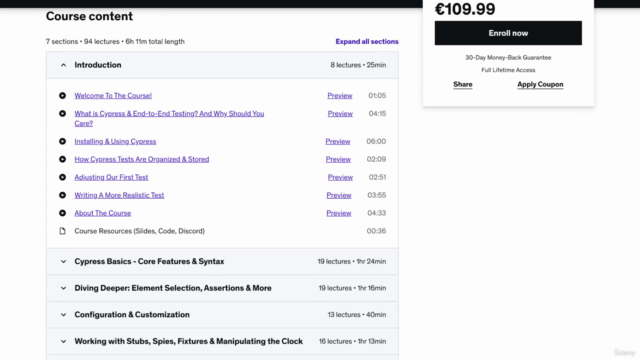Cypress End-to-End Testing - Getting Started

Why take this course?
🚀 Cypress End-to-End Testing - Getting Started
🎓 Instructor: Academind by Maximilian Schwarzmüller
🧐 Are you ready to master E2E testing with Cypress?
Automated testing is the linchpin of reliable application development, and for web developers, it's a non-negotiable skill. Ensuring your website functions as intended across different browsers and environments requires a robust testing suite. That's where Cypress End-to-End Testing - Getting Started comes into play!
🔍 Why Learn E2E Testing with Cypress?
✅ Comprehensive Coverage: Automate browsers and detect bugs before your users do.
✅ User Flow Simulation: Test as real users would, with clicks, typing, and more.
✅ Realistic Assertions: Ensure your web pages behave exactly as they should.
✅ Efficient Third-Party Testing: Confidently test integrations with external services or libraries.
✅ Advanced Scenarios: From HTTP requests to database interactions, you'll learn it all!
🛠️ What Will You Learn in This Course?
-
🧪 Introduction to Cypress: Understand what Cypress is and why E2E testing is crucial for your development workflow.
-
🚀 Getting Started with Cypress: Learn how to set up and use Cypress for running E2E tests.
-
✍️ Writing E2E Tests: Dive into writing tests that simulate real user interactions.
-
🧐 Assertions: Master the art of creating assertions to validate the correct functioning of your web application.
-
✨ Cypress Core Features & Concepts: Explore Cypress's powerful features and understand how they can enhance your testing suite.
-
🛠️ Using Basic Cypress Commands: Command the basics of Cypress to run E2E tests efficiently.
-
🧙♂️ Exploring Advanced Cypress Concepts: Get hands-on with more advanced features like testing third-party code, handling network requests, and authenticating users.
-
🚀 Testing Authentication Flows: Learn to test user login and authentication processes effectively.
👨🏫 Who Is This Course For?
This course is designed for web developers with a passion for automation and quality assurance. You should have:
-
✅ Basic Web Development Knowledge: Familiarity with HTML, CSS, and JavaScript is essential.
-
✅ JavaScript ES6+ Understanding: Proficiency in modern JavaScript syntax will help you get the most out of this course.
By the end of this course, you'll have a rock-solid foundation in Cypress, enabling you to tackle complex testing scenarios with confidence. Whether you're new to E2E testing or looking to refine your skills, this course is your stepping stone to becoming a Cypress expert. 🏆
Join Academind by Maximilian Schwarzmüller and start your journey towards flawless web applications with the power of Cypress. Enroll now and take your testing skills to the next level! 🌟
Course Gallery




Loading charts...
Comidoc Review
Our Verdict
Cypress End-to-End Testing - Getting Started is a solid choice for those looking to add automated E2E tests with Cypress. Despite minor issues and areas for improvement, this course offers valuable insights and practical examples based on real projects. The instructor's expertise provides confidence in the accuracy of the content, which focuses on core Cypress concepts while offering ample opportunities for practice to reinforce learning.\n\nOverall, there are few alternatives that offer such comprehensive coverage of Cypress end-to-end testing, making this course a worthwhile investment for both beginners and experienced developers.
What We Liked
- Comprehensive coverage of Cypress end-to-end testing, from basics to advanced techniques
- Realistic examples and workflows that can be applied directly to projects
- Instructor has deep expertise in the subject matter, making for high-quality content
- Covers essential Cypress features such as waiting, chaining commands, and network requests
Potential Drawbacks
- Installation process might not always match up with the course content
- Exercises could be restructured to reduce tedious setup and navigation
- Some explanations may assume prior knowledge, potentially causing confusion for beginners
- Page Object Model design pattern is not explicitly covered in the course